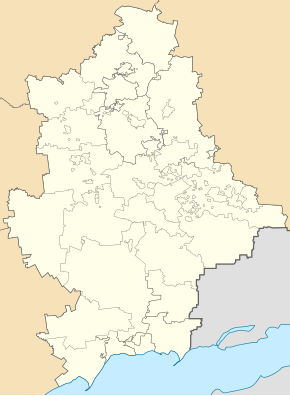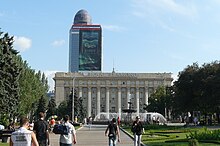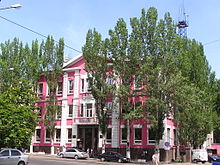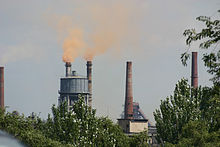Donetsk
| Donetsk | ||
| Донецьк | ||

|
|
|
| Basic data | ||
|---|---|---|
| Oblast : | Donetsk Oblast | |
| Rajon : | District-free city | |
| Height : | 169 m | |
| Area : | 385.0 km² | |
| Residents : | 953,782 (December 2014) | |
| Population density : | 2,477 inhabitants per km² | |
| Postcodes : | 83000-f | |
| Area code : | +380 62 | |
| Geographic location : | 48 ° 0 ' N , 37 ° 48' E | |
| KOATUU : | 1410100000 | |
| Administrative structure : | 9 Stadtrajone , 1 city, 2 SsT , 7 villages | |
| Mayor : | Olexandr Lukianchenko | |
| Address: | вул. Артема 98 83050 м. Донецьк |
|
| Website : | gorod-donetsk.com | |
| Statistical information | ||
|
|
||
Donetsk ( Ukrainian Донецьк , [ doˈnɛt͡sʲk ]; Russian Донецк , [ dɐˈnʲetsk ]) is a city in eastern Ukraine , the center of the Donbass coalfield and with around 1.1 million inhabitants (with suburbs) was the fifth largest city in the country before the Ukraine War . The current number of inhabitants cannot be determined exactly. The city is an important industrial location in the country, the seat of several universities and an important cultural center.
Donetsk is the capital of Donetsk Oblast , which has about 4.37 million inhabitants. From 1924 to 1961 the city was called Stalino , before that it was called Jusowka , named after the British founder John Hughes .
geography
Donetsk lies in a predominantly agricultural steppe landscape, which is surrounded by small forests, hills (natural and spoil heaps from mines) and lakes. The city lies on the Kalmius River, which flows into the Sea of Azov around 120 km south of Donetsk, near Mariupol , which is traditionally a popular holiday destination for the population.
The municipality is divided into nine Stadtrajone ( Rajon Budyenny , Rajon Voroshylovs'kyi , Rajon Kalinin , Rajon Kiev , Rajon Kirov , Rajon Kuibyshev , Rajon Lenin , Rajon Petrov and Rajon proletariat ), a city ( Mospyne / Моспине), two settlements of urban type ( Horbatschewo-Mychajliwka / Горбачево-Михайлівка, Laryne / Ларине), seven villages ( Byrjuky / Бирюки, Werbowa Balka / Вербова Балка, Hryschky / Гришки, Mychajliwka / Михайлівка, Nowodwirske / Новодвірське, Oktiabrske / Октябрське - officially since 2016 Kyslytsche / Кисличе, Temryuk / Темрюк) and Pawlohradske / Павлоградське. The SsT Horbachevo-Mychajliwka and the city of Mospyne are administratively assigned to the Proletariat Rajon, and the city itself has the seven villages. SsT Laryne belongs to Budjonnyj Rajon and the village Pavlohradske is subordinate to it.
history
Etymology: The city's name comes from the Donets River , which translates as "little Don ".
1869 to 1917
In 1869 the Welshman John Hughes founded a metallurgical factory with the modern technical equipment he had brought with him from England and 100 skilled workers, around which a settlement quickly developed. The settlement was named after Hughes' Russian spelling close to the pronunciation Юз , Jus Jusowka ( Юзовка ). At the turn of the century the place already had about 50,000 inhabitants.
1917 to 1991
1917 Yuzovka became a town and in 1924 in honor of Stalin in Stalino renamed.
During the Second World War , the city was almost completely destroyed. From October 28, 1941 to September 5, 1943, Stalino was under German occupation. The Germans' brutal crackdown on the Soviet population in general, and against all Jews in particular, had got around in the city as early as the summer of 1941 - as a result, many residents fled east instead of coming under German occupation. Almost 200,000 residents (40% of the total population), including a large number of Jews, managed to flee, so that in October 1941 only about 290,000 people lived in the city. Of the remaining population , the German occupying power murdered around 60,000 people, 17,000 of them Jews.
The city, which was practically newly built in the typical Soviet drawing board style after the end of the war, with lots of greenery, was designed to be much larger than before by incorporating some villages. Since 1961 the city has been called Donetsk, after its location in the Donets Basin, named after the Siverskyi Donets . In the 1960s, Donetsk was named the greenest industrial city in its population class by UNESCO . Donetsk rightly called itself “The City of Millions of Roses”.
Since 1991

Since the dissolution of the Soviet Union in 1991, Donetsk has been part of independent Ukraine .
During the war in Ukraine since 2014 , there were violent clashes between pro-Russian demonstrators and supporters of the Ukrainian interim government. The regional administration building was occupied several times by pro-Russian demonstrators; the Russian flag was hoisted on the roof . In connection with these riots, the Russian Foreign Ministry declared that Russia was ready to protect "its compatriots and its citizens in Ukraine". On March 21, 2014, the OSCE sent observers to Donetsk, among others. On April 28, 2014, the last pro-Ukrainian demonstration took place in Donetsk, which broke up in the face of violent, makeshift armed groups that roamed the city and "spread fear and terror". Since then, the city has been under the control of the internationally unrecognized People's Republic of Donetsk and serves as its capital. On May 25, 2014, one day after the presidential election in Ukraine , the Donetsk airport was occupied by pro-Russian separatists, but shortly afterwards it was recaptured by Ukrainian government troops . The airport later became the focus of fighting between the two sides. Contrary to various ceasefire agreements, the separatists tried to conquer the airport grounds, which they finally succeeded in January 2015 . Even after that there were fierce fighting in the Donetsk area, which lies on the border between the areas of the Donetsk Basin controlled by separatists and government troops . The city itself was shelled with heavy artillery by the Ukrainian army in early 2015, killing 17 soldiers and four civilians, according to the separatists. A hospital was also hit. Both parties to the conflict accused each other of being responsible for the incident. Even if the use of heavy weapons was prevented by the Minsk Agreement of February 2015 , battles flared up again in 2017 in the city area. The supply situation for the civilian population is precarious; many people, especially the elderly, are dependent on aid supplies.
Population development
The population of Donetsk rose from 164 in 1870 to 1,020,000 in 1979 in just 110 years. Since Ukraine gained independence, the city's population has been falling.
|
In 2001 the population of Donetsk consisted of the following ethnic groups:
|
language
Donetsk is one of those major Ukrainian cities with a predominantly Russian-speaking population . Exactly how high the proportion of Russian speakers in the city is is a matter of debate. According to the Donetsk Statistics Office, at least 11% of Donetsk citizens are native Ukrainians. According to a study from 2011 in a test group in Donetsk, only 1% of the participants spoke only Ukrainian on a daily basis. 12% of the test subjects use Ukrainian and Russian equally, while 87% of the participants only spoke Russian. As a result, 99% of Donetsk people, including bilingual people, speak Russian on a daily basis and only 13% speak Ukrainian.
economy
Donetsk is an important center of heavy industry and coal mining. There are mainly hard coal mines , some of which are directly under the city , in which serious accidents have occurred repeatedly recently.
Coke, steel and chemicals in Donetsk and the surrounding Donets Basin region hold Ukraine's central economic resources. No other region in the country had a similarly high standard of living before the post-Soviet economic crisis. Since 1991 oligarchs such as Rinat Akhmetov have played a major role in the economic region.
In the meantime, not only the mining industry is struggling with economic efficiency problems. The steel industry also produces with outdated systems. In contrast to the Kharkiv region, a net contributor to the Ukrainian central budget, the Donetsk region had to be subsidized.
education
Donetsk is a city with several universities and colleges and their scientific research institutes , which mainly deal with topics of the industries located here. Hundreds of students from Germany and the former GDR have been trained at these schools since 1970 .
- Donetsk National Technical University : This university was founded in the 1930s as the "Polytechnic Institute". In close cooperation with the University of Magdeburg , engineers in the field of automation and mechatronics are trained at the "German Technical Faculty" in Donetsk .
- Donetsk National Medical University : This university was founded in 1930 as a Medical Institute.
- Donetsk National University : This university was founded in 1965 and emerged from the "Pedagogical Institute" founded in 1937.
- Islamic University of Donetsk , u. a. with the “Center of Islam in Ukraine ”.
- Donetsk Institute of Tourism or Donetsk Institute of Tourist Business (DITB).
traffic
Air and rail transport
Until the outbreak of the war in Ukraine, Donetsk Airport , which was one of the most popular airports in the Ukraine, had no transfer connections to Germany and Austria.
city traffic
In the city trams (the Donetsk tram since 1928) run on 12 lines, as well as trolleybuses, omnibuses and collective taxis. Since 1992 the metro has been built with varying degrees of intensity . Financial shortages and strikes due to outstanding wages repeatedly led to the interruption and in 2011 to the abandonment of construction work. The first line with six stations was supposed to be inaugurated for the European Football Championship in 2012 , but has not yet been completed (2016).
Culture and sights
- Opera house, music-drama theater (built in 1961 by Jelisaveta Natanovna Chechik ), philharmonic orchestra and several small theaters
- The ballet is known from Vadim Pissarew .
- TV transmission mast at the new television center: Height: 360 meters
- Donbass Arena : new football stadium
- Pushkin Boulevard, a 1.7 km long inner-city park with a collection of important monuments
- The park of the blacksmiths at the city administration building
POW camp after World War II
In the time after the end of the German occupation, the Soviet Union set up two POW camps 280 (until 1954) and 473 for German POWs from World War II. Seriously ill people were cared for in prisoner-of-war hospitals 2829 and 8987 . There were several cemeteries for deceased prisoners of war.
Sports
Donetsk is known in international sport in the following areas:
- Pole Vault ( Serhij Bubka )
- Football ( Shakhtar Donetsk , Metalurh Donetsk )
- Ice hockey ( HK Donbass Donetsk )
- Basketball ( BK Donetsk )
- In Donbass Equicentre jumping competitions were held from 2010 to 2013 international.
Documentaries
- Video The Other Chelsea - A story from Donetsk (Jakob Preuss, D / UK, broadcast on ZDF on June 28, 2011, 0.15 a.m.) in the ZDFmediathek , accessed on January 26, 2014. (offline)
- WELTjournal: Mein Donezk , broadcast on ORF , in WELTjournal magazine on August 17, 2016, 10:30 p.m., 30 min., By Christian Wehrschütz , accessed on August 21, 2016 ( page no longer available )
Personalities
Town twinning
A partnership had existed with the then Magdeburg district since the 1960s , based on the common ground as an important center of heavy engineering in the respective country. However, it was terminated by the German side in 1997. In this context, there is a lively exchange between Otto von Guericke University and the National Technical University of Donetsk.
Since 1987 Donetsk has also been the twin town of Bochum , with which there is a very lively exchange at various levels (including youth and Caritas). Between 1987 and 2003 over 10,000 residents visited one of the twin cities.
There is also a partnership with the Russian city of Rostov-on-Don and the Georgian city of Kutaisi .
Web links
- Comprehensive travel guide to Donetsk - English
- Donetsk National Technical University
- Donetsk National University
- Climate in Donetsk
Individual evidence
- ↑ a b Головне управління статистики у Донецькій області
- ↑ Ulrich Schmid, Donetsk: The War in Ukraine: Donezk Ghost Town - NZZ, 10.9.2014
- ↑ Donetsk, our twin city since 1987
- ↑ Верховна Рада України; Постанова від 05.12.2016 № 1351-VIII Про перейменування окремих населених пунктів та районів на тимчасово окупованих територіях Донецької та Луганської областей
- ^ Andreas Kappeler : The children of Soviet communism feel betrayed NZZ, June 25, 2014; Subtitles of the printed edition; The descendants of the industrial workers of the Donbass, pampered in the Soviet era, mourn their former privileges
- ↑ The short reign of the "people's governor" Gubarev , The World from March 9, 2014
- ^ A dead person in riots in Donetsk , Ukraine , Die Welt, March 14, 2014
- ↑ Moscow: Russia will take compatriots in Ukraine under protection, RIA Novosti website from March 14, 2014
- ^ Crimean crisis: OSCE sends 100 observers to Ukraine , Spiegel Online on March 22, 2014
- ↑ Golineh Atai : WDR Montalk March 16, 2015 ; Minute 45; accessed on July 21, 2015 (not available)
- ↑ OSTUKRAINE: Methods of Terror in Donbass in the Luzerner Zeitung of December 22, 2017; accessed on July 31, 2018
- ↑ FAZ.net: After the presidential election deaths in skirmishes in Donetsk .
- ↑ OSCE observers are in the hands of separatists in welt.de ; last accessed on May 28, 2014.
- ↑ Hospital in Donetsk shot at with artillery , Die Zeit, February 4, 2015
- ^ Donetsk - a city torn by war , MDR of May 12, 2017
- ↑ 1897 first census in the Russian Empire, 1926–1989 census of the USSR, 1998 and 2006 census of Ukraine.
- ↑ http://donetskstat.gov.ua/statinform/chisl_ruh1.php?dn=0113
- ↑ http://history.org.ua/LiberUA/NatsSklRMDonObl/NatsSklRMDonObl.pdf
- ↑ http://history.org.ua/LiberUA/NatsSklRMDonObl/NatsSklRMDonObl.pdf
- ↑ http://ukrainianweek.com/Society/47497
- ↑ Discover Ukraine: Donetsk, The Park of Blacksmiths. In: discover-ukraine.info. December 26, 2011, accessed April 7, 2020 .
- ↑ Maschke, Erich (Ed.): On the history of the German prisoners of war of the Second World War. Verlag Ernst and Werner Gieseking, Bielefeld 1962–1977.
- ^ City partnership on: "German-Ukrainian Forum"















